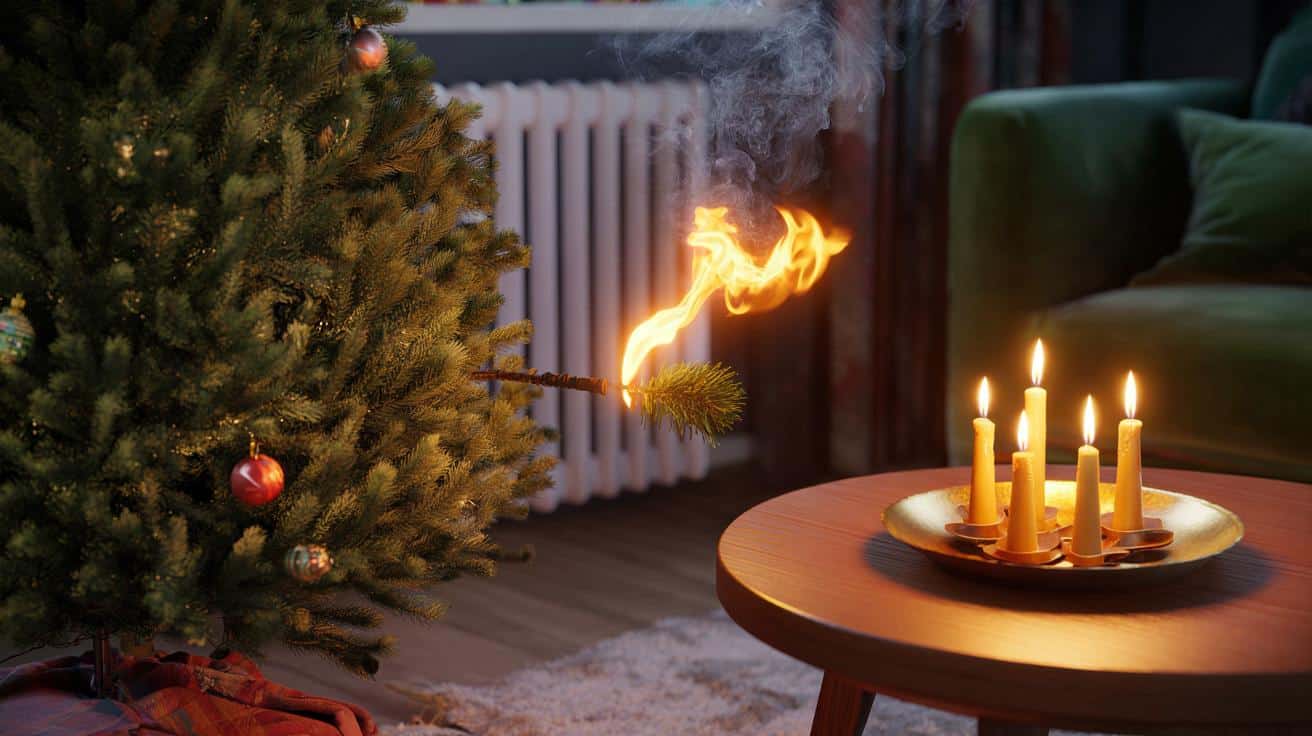A fat fir twinkles, a wreath glows on the table, the heating hums in the corner. Hidden in that cosy picture sits a cruel truth: a dry Christmas tree can turn a room into an inferno far faster than a wreath with real candles. The difference isn’t just tradition. It’s physics, fuel, and time.
On a damp December evening in Kent, I watched a family tree shed needles like confetti. The cat brushed past a branch and a dusting of brittle green hit the carpet, tiny arrows that snapped underfoot. Across the room, four beeswax candles flickered in a brass wreath, steady and low, a warm halo on the table. *I could smell the resin before I saw the tiny puff of smoke.* The room felt safe and bright. The air said otherwise.
The hidden firepower of “holiday hygge”
A dry Christmas tree is not just “wood”. It’s a vertical, ventilated bundle of thin needles and twiggy branches, soaked in resin and arranged like a chimney. Once a needle catches, flames race upward, preheating the next tier, and the next. A wreath with real candles, by contrast, sits low and still. Its flame is small, its fuel contained in wax, and the heat release stays local unless something combustible leans in. Same season. Totally different fire behaviour.
Fire labs have shown this in brutal clarity. In widely shared tests by the National Institute of Standards and Technology, a dry fir ignited and pushed a room to flashover in under a minute; a well-watered tree struggled to sustain flame and often self-extinguished. UK crews tell similar stories after December callouts: the fastest, most violent living-room fires start on trees that have quietly dried by the radiator. A wreath candle can start trouble too, but it usually acts like a match, not a bonfire.
Here’s why. Moisture in a fresh tree absorbs heat and slows pyrolysis, the process that turns solid fuel into flammable gases. When the moisture is gone, those needles offer huge surface area to the flame, each one a tiny wick. The tree’s shape creates a “stack effect” that pulls air up through the branches, feeding the fire and carrying heat to higher fuels. A single dinner candle emits around the heat of a small bulb; a fully involved dry tree can roar into the megawatt range. One is a spark. The other is a storm.
Make your tree boring to burn
Start with water. Cut 2–3 cm off the trunk base when you bring it home, pop it straight into a stand that holds at least 3–4 litres, and keep that reservoir topped up daily. Aim for cool placement: at least a metre from radiators, log burners, or sunny windows. Choose LEDs for lights; they give off little heat and sip power. Run them on a timer so they’re not left glowing into the small hours. Pick a tree that drops few needles when shaken and smells alive, not stale.
Mind your wiring. Use one quality extension lead per plug-in, not a daisy chain of bargain blocks. Check every bulb and cable for nicks before they touch branches. Keep candles on stable, heatproof bases, and park them where sleeves and tinsel can’t flirt with the flame. We’ve all had that moment when the room feels “watched over” by the candles — keep a human there too. Let’s be honest: nobody really does that every day. Design your room so a lapse doesn’t bite.
Treat routine like a seatbelt: boring, but it works. **Switch everything off at the wall before sleep.** Snuff candles, unplug chargers, and water the tree if the stand looks thirsty.
“A dry tree is like parking a column of petrol-soaked kindling in your lounge,” a London firefighter told me. “You won’t get a second chance once it lights.”
- One-minute bedtime sweep: lights off, candles out, doors closed.
- Midweek: finger-test the stand water, lift a branch — if needles snap, it’s drying fast.
- Guests over? Move candles to the centre of the table, not the edge.
- Keep a small water mist extinguisher or fire blanket near the kitchen, not behind the tree.
**If it feels faffy, remember you’re trading small habits for massive safety.**
The meaning of a safer glow
We decorate to slow time — to make a darker month feel warmer and more human. That instinct is good. The trick is not to hand the season a fuse. Hydrated trees still smell like forests, LEDs still sparkle like starlight, and candles still soothe when they sit well clear of fuel. No drama needed. Change how the heat sits in your room and you change the odds. You also change what you notice: the whisper of needles, the quiet of a dark switch, the breath you take before bed. Small rituals, big peace of mind.
| Point clé | Détail | Intérêt pour le lecteur |
|---|---|---|
| Dry tree vs wreath risk | Vertical, ventilated fuel load vs small, contained flame | Understands why the tree can flash a room in under a minute |
| Water and placement | Daily reservoir checks; keep at least 1 m from heat sources | Simple habits that dramatically reduce ignition chance |
| Night routine | Power down, snuff, close doors, quick water check | Low-effort checklist that prevents the most common incidents |
FAQ :
- How fast can a dry Christmas tree ignite?In lab demonstrations, a dry tree can ignite and push a living room to flashover in under a minute, giving occupants very little time to react.
- Are real candles on a wreath ever “safe”?No open flame is risk-free, but a stable wreath on a heatproof surface, placed well away from anything combustible, and never left unattended, can be managed responsibly.
- LED or older filament lights — which are safer on the tree?LEDs run cooler and draw less power, lowering the chance of ignition and socket overload while still giving bright, crisp light.
- How do I know if my tree is dangerously dry?Needles snap rather than bend, the trunk drinks little water, and light touches shed lots of needles — all signs it’s time to remove lights or retire the tree.
- What should I do if the tree catches fire?Get everyone out, close the door to the room to slow the fire, call 999 from outside. If it’s tiny and contained, a water mist extinguisher can help — but don’t delay your escape.








